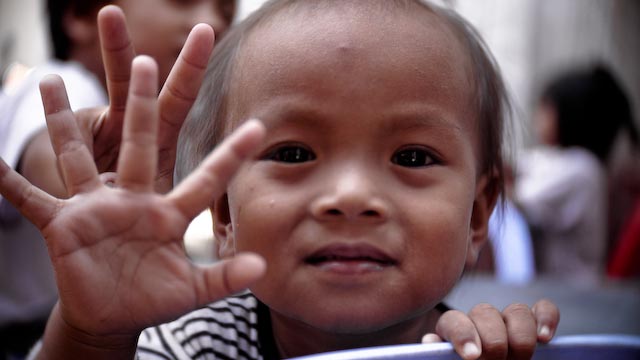I expect most of you know as much, more or less, about contemporary Cambodian history as I do. Back during the tragic days of the highly misguided US intervention in the Vietnamese civil war, its neighbour Cambodia was busy exploring the potential of its own form of Communism under the leadership of Saloth Sar (Pol Pot) fighting a covert civil war against Prince Sihanouk initially and then the US backed Lon Nol. The history of the rise to power of Pol Pot and the Khmer Rouge reads more like a complicated game of chess than regular revolution. Along the way the country also found itself on the receiving end of mass illegal US bombing designed to teach the “commies” the might of B52 bombers in the air.
The only profits of these and similar actions collaboratively between the US, Soviet Union and China fell directly into the bank accounts of munitions manufacturers who, thanks to the “arms length” character of their murderous trade, could never
be brought to trial for war crimes. Nor, it would seem, could Batman or Robin, aka Nixon and Kissinger, despite their heartless determination to bomb the Vietnamese Communists and their supporters “back into the stone age”. They meant it. Can you imagine? So it was that the once neutral nation of Cambodia became embroiled in one of the messiest conflicts of the last century. No one would suggest that their internal leadership was blameless but, regardless, the character of the US government/Military action contributed significantly to the ensuing destabilisation of the order within the fragile power structure and opened the door for the insanity that came with Pol Pot and his, UN backed, Khmer Rouge’s socially genocidal form of communism.
To add insult to injury the story of the wholesale planting of land mines and its consequences is one of the most tragic imaginable, especially when you get to meet so many of its living survivors in your travels.
I am now on a Bangkok Airways flight from Phnom Penh to Bangkok sitting in seat 5D ( the Canon seat!) behind an equally tall guy who keeps flexing backwards and crushing my bones as I contemplate the very different scene I’ve just left that my daughter Daisy inhabits back in Battambang in Cambodia. She works tirelessly as the sponsorship co-ordinator for one of the many Non Government Organisations that are dedicated to bringing social advantage and justice to neglected parts of the 3rd world. The Cambodian Childrens’ Trust is dedicated to helping the people, children and young adults, of this beautiful country recover and move forward positively from the trauma of more than two generations of conflict, civil war and neglect by the 1st world, with its only natural resources being their power of spirit, their resilience, intelligence and their smiles.
Cambodia would be much smaller on the map of today’s world if it weren’t for the efforts of a small handful of leaders of these dedicated NGOs, notably, but far from exclusively: Sebastien Marot and Friends International; the US celebrity connection of Angelina Jolie and Brad Pitt and their Maddox Jolie-Pitt Foundation; and CCT set up by the irrepressibly feisty Tara Winkler, who conscripted Daisy out of a small cafe in Bondi Junction, Sydney, just over a year ago. The common thread of visionary NGOs now is in creating and nurturing an understanding of sustainable development, helping the people and the nation, wherever in the world, to grow and flourish on its own in the long term and assist in creating sustainable systems that avoid dependance on Aid. By nature this encourages not only a sense of responsibility but also a genuine sense of pride.
What motivates these people? I can only really offer a guess at the answer to that, but to my mind it would begin with heartache; an overwhelming desire to appease personal heartache at coming face to face with severely disadvantaged children, primarily, in a nation that has been left adrift in a state of horrendous shell shock, wondering collectively what they did to deserve being abandoned without mothers, fathers, sisters or brothers. Most of us in the fortunate world are oblivious to how this must feel, to be orphaned by wars, to have our human potential discarded while we are left to drown, desperately gasping for nurture and hope. For us it is completely outside our scope of imagination.
But this is real and the crimes of over forty years ago are still claiming victims. Many young adult Cambodians that I’ve met in the last twelve months of visiting Daisy are a genuine inspiration. They’re smart, wise, motivated and spiritually beautiful while their stories are heartrending and speak volumes to the human capacity for survival. But alongside them are the young children who, thanks to these organisations, are given some of the nurture they crave through the tireless love and effort of compassionate fellow Cambodians and the international volunteers who believe in the power of collecting raindrops in the ocean.
Further consideration might lead you to wonder how these types of organisations operate, how they manage, daily, to wheel out not just the love but the physical features of aid: food, housing, education and health support? They’re certainly not funded by governments, that’s what defines a Non Government Organisation and if the truth be known, cynically, many governments across the globe take advantage of them to abrogate certain of their crucial responsibilities to their own most disadvantaged people. But, that said ( and it’s a personal opinion based on a ‘gut feeling’ not data), many of those governments are almost certainly struggling to come to terms with their responsibilities and priorities as the political parents to their people.
So NGOs survive on the generosity of individuals, sponsorships and occasionally on larger donations from individuals or corporate organisations who understand the value of nurturing a nation from the ground base of its people. But this is not a rich man’s sport. Sure there are sharks in the NGO pool and some give the concept of individual aid a bad name but they should never be allowed to blur our image of aid organisations. Please remember that my beautiful daughter is now a leading light in this world, working for just enough to eat cheaply and to keep a roof over her head with occasional running water. Her profit, along with that of her colleagues, is found in her heart and is derived from seeing results.
I’m certain that a large proportion of you who have been bothered to read this far already give to the global charities, drop change at airports and have your own ways generally to appease constantly challenged consciences. It’s a tough road for all of us: who to say yes to, who to say “not today” to. On our own first world streets there’ s enough sadness already. But our world has not suffered the kinds of dreaded pain that has been inflicted on the people of countries like Cambodia. Our world has sustainable infrastructure that even the least fortunate can access with relative ease in most cases and generally without fear.
My inspiration to write this is not just my daughter but all the people I’ve met over the years who give so generously of their lives to people often not even empowered to cry for help, along with my belief that we all need to look carefully at the height of our financial support bar for charitable organisations. Is it really high enough? Is there more we can do? Do we devote enough time to understanding the absolute inequality that is spread across this small globe of ours? Am I starting to sound like Bob Geldof? If only I was as informed, eloquent and proactive as he is.
Thanks Daisy and all at CCT for being so inspirational. You rock; as do the people who inspire you all.











